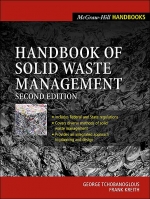Tab Article
THE FIRST TRULY INTEGRATED APPROACH TO THE MUNICIPAL SOLID WASTE PROBLEM
UPDATED AND EXPANDED COVERAGE OF FEDERAL AND STATE REGULATIONS
In a world where incinerators are no longer an option and landfills are filled to capacity, cities are hard pressed to find a solution to the problem of what do with their solid waste. In this practical resource more than 20 top industry and government experts provide all the tools needed to successfully plan, design, implement, and manage a cost-efficient, environmentally sound municipal waste management system.
Focusing on the six primary functions of an integrated system: source reduction, toxicity reduction, recycling and reuse, composting, waste-to-energy combustion, and landfilling – the Handbook fully explores each technology and examines its problems, costs, and legal and social ramifications.
Addressing both the technical and regulatory aspects of municipal waste disposal, the authors cover such wide-ranging topics as facility siting, financing a sold waste management program, environmental risk assessment and considerations, oil and battery recycling, tire disposal, ash disposal, emission monitoring and control, and much more.
This new Second Edition has been revised to include : updated chapters on solid waste characteristics, recycling, landfilling, and federal and state regulations. There is also new material on optical separation techniques, weight-based collection systems, yard waste management, economies, collection cost and technologies, and safety and risk assessment.
Supplemented by revealing case studies and hundreds of how-to illustrations, this is an indispensable working tool for engineers and public officials interested in planning, designing, constructing, or managing the most effective waste management facility possible.


